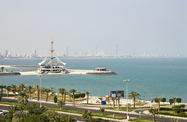 What greater role do you think the Saudi private sector can take with the launch of Vision 2030?
What greater role do you think the Saudi private sector can take with the launch of Vision 2030?
PADDY PADMANATHAN: About 80% of fixing any problem is becoming conscious of it and articulating a plan to fix it. That is what Saudi Arabia has achieved with Vision 2030 and the National Transformation Programme (NTP) so far. No other country in the world has developed such detailed set of key performance indicators for monitoring the government’s performance in restructuring the national economy. Since the launch of the NTP, the government undertook a deep internal restructuring and focused on strengthening regulatory and competition authorities, setting the ground for privatisation.
As this process is completed, the onus will be on the private sector to perform. For decades, the Saudi private sector has been characterised by a rent-seeking attitude, with a general absence of a culture of taking and managing risks that has produced only a few real entrepreneurs. Traditional foreign investors to Saudi Arabia have also been acting as rent-seekers in a way, via the local private sector, and it will take time for them to adjust to the new normal.
In light of the opportunities stemming from Vision 2030, a new generation of young entrepreneurs will be asked to step forward. The main opportunities are now in the small and medium-sized enterprises to feed into local value chains of larger national industries. Small parts suppliers can really take a bigger role and become a major driver of the Saudi economy.
How is the renewable energy strategy being rolled out to diversify power generation sources?
PADMANATHAN: With the need for water and power growing, the ability to provide more of these resources at the lowest possible price in a sustainable, self-financing manner is essential. The majority of assets in the Saudi utilities sector are state-owned. Most of these assets will be privatised and efficiency requirements will be enforced on private sector buyers.
As for investments in additional power capacity, renewable sources have recently emerged as a cost competitive option, especially during peak load hours. Saudi Arabia aims to have 9.5 GW of renewable energy capacity operational by 2023, implying that all projects will have to be awarded at least two or three years before then. The first round of 2017 tenders will involve a 300-MW photovoltaic power plant and a 400-MW wind power plant. The investments for these projects will be somewhere around $515m and $300m, respectively. As the two bids get awarded towards the end of this year and early next year, construction is expected to commence in Q1 2018.
Beyond these first stages, there is theoretically no reason why Saudi Arabia should not be able to reach the targeted 40 GW capacity and $40bn investment in renewable energy in the next 15 years. This will allow for a new private sector to develop its own knowledge, employment capacity and technology. We expect the first round of tenders to include progressive local content and Saudisation requirements in order to allow the sector to grow at the right pace. Although local content requirements could represent a challenge at the first stages of the industry, I believe 95% local content rates might be achieved in the next five years, provided there is a clear pipeline of projects going forward.
How competitive is renewable energy as a feedstock to local energy-intensive industries?
PADMANATHAN: The local energy-intensive industrial sector is currently enjoying significant subsidies of SR0.16 ($0.04) per KWh, which is clearly giving them a competitive advantage. If fossil fuels, which currently comprises the fuel mix of the Saudi generation portfolio, are priced at the more cost-reflective basis, as input to electricity generation, the tariff will be more like SR0.35-0.38 ($0.09-0.10) per KWh for 24-hour electricity.
The government of Saudi Arabia has clearly stated that it is their firm intention to remove subsidies and price electricity at its full cost-reflective tariff by the year 2020. Thus, left alone, the retail US-cent price of electricity will end up being in the double-digits per KWh, especially given that transmission and distribution need to be added to the cost of generation.
However, renewable energy does offer some promise. Solar energy using photovoltaic technology is already able to deliver at a cost of $0.035 per KWh, albeit only when the sun is shining. The batteries needed for storage are not a commercially viable product yet. Concentrated solar power technology captures the heat of the sun and is able to store it in molten salt for night-time usage, meaning it is already able to deliver 24-hour renewable energy at $0.12 per KWh.
With renewable energy costs continuing to go down, it is our firm view that constant reliable electricity using renewable energy will cost no more than $0.07 per KWh within the next few years. Energy-intensive industries could receive electricity at below $0.10 per KWh, including the cost of transmission and distribution. However, these industries will have to cope with the doubling of their current subsidised electricity costs. They all, therefore, will also need to double and treble their efforts to capture as much value as possible from energy efficiency in order to reduce electricity consumption.
Paddy Padmanathan is the President & CEO of ACWA Power

 What greater role do you think the Saudi private sector can take with the launch of Vision 2030?
What greater role do you think the Saudi private sector can take with the launch of Vision 2030?